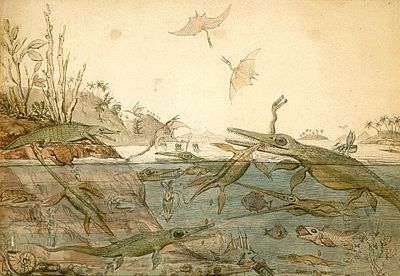Henry Thomas de la Bèche
Sir Henry Thomas De la Bèche (born February 10, 1796 in London , † April 13, 1855 there ) was an English geologist .
life and work
De la Bèche studied geology after his military service and made a geological trip through Switzerland and Italy in 1819 . In the same year he became a member of the Royal Society .
Together with William Daniel Conybeare he carried out geological studies in England, where he discovered a plesiosaur , among other things . In 1819, based on his research in Lake Geneva, he introduced the term thermocline as a temperature jump layer in a stratified lake into scientific terminology. In 1825 he traveled to Jamaica and examined the geognostic structure of the island.
Henry Thomas de la Bèche made geognostic maps and founded the Museum of Practical Geology in London. England owes him a detailed geological exploration and description of the country, which he carried out in large part at his own expense. As the first director of the "Geological Survey of Great Britain" (now British Geological Survey ) founded by him in 1835 , the first national geological service, he worked on behalf of the government.
In 1848 he was raised to the nobility as a Knight Bachelor . In 1849 he was elected to the American Academy of Arts and Sciences and in 1853 to the Académie des Sciences in Paris. Shortly before his death, he was awarded the Wollaston Medal for special achievements in the field of geology. He has been the namesake of the Beche Blade mountain ridge in Antarctica since 1971 .
Duria Antiquior

In 1830 de la Bèche painted the watercolor Duria Antiquior - A more Ancient Dorset (" Ancient Dorset"). It is the first reconstruction of a fossil habitat in its entirety, here the Lower Jurassic of the southern English county of Dorset , with the interplay of its various elements of fauna and flora ( paleoecology ). The picture circulated in Victorian England in numerous legal and illegal lithographed copies and served almost all painters as a template for depicting prehistoric landscapes and their living world .
In the center of the scene are Plesiosaurus and Ichthyosaurus fighting with each other with pterosaurs circling above them ( Dimorphodon macronyx , originally described as Pterodactylus macronyx ). The reconstruction of these animals goes back to the three most remarkable finds of the professional fossil collector Mary Anning (1799–1847) from Lyme Regis in Dorset. Henry de la Bèche, who had spent his childhood in Lyme Regis, sold copies of his painting in order to use the proceeds to support the impoverished Anning, to whom British geology owed much.
He reconstructed the animals according to the scientific ideas of the time, but the depiction is characterized by a humorous exaggeration: Most of the animals, which are huddled together in an unnaturally small space like a menagerie picture, eat or are eaten, some give off feces - a detail that the Copies were often left out. The painting attracted attention in German-speaking countries early on, as early as February 1831, the Prussian geologist Leopold von Buch presented Duria Antiquior to the public in Berlin. From the manuscript of the lecture it can be seen that this illustration, with its appearance in the 19th century, raised new questions about the processes of geological changes.
Fonts
- Geological notes . London 1830
- Sections and views of geological phenomena . 1830
- Geological manual . 1831 (German by Heinrich von Dechen , Berlin 1832)
- Researches in theoretical geology . 1834 (German, Quedlinburg 1836)
- How to observe . 1835
- Geological observer . 1853 (German by Ernst Dieffenbach , Braunschweig 1853)
literature
- Tom Sharpe: The Papers of HTDe La Beche (1796-1855) in the National Museum of Wales (Geological S.) . ISBN 0-7200-0454-3 (engl.)
Individual evidence
- ↑ Peter Wellnhofer : The great encyclopedia of the pterosaurs . Mosaik Verlag, Munich 1993. pp. 168-169
- ↑ 'Duria Antiquior - a more ancient Dorsetshire' by Henry Thomas de la Beche, 1830 (watercolor) ( Memento of the original from January 12, 2006 in the Internet Archive ) Info: The archive link was inserted automatically and has not yet been checked. Please check the original and archive link according to the instructions and then remove this notice. . Gathering the Jewels
- ↑ Stephen Jay Gould: Dinosaur Deconstruction . Discover, Jan. 10, 1993
- ^ Martin Rudwick : Encounters with Adam, or at least the hyaenas. Nineteenth-century visual representations of the deep past . In: James Richard Moore: History, Humanity and Evolution: Essays for John C. Greene . Cambridge University Press, 1989. pp. 231-252 Google Books: Restricted Preview
- ↑ Remarks on a scene, depicting the primeval world - A talk given by Leopold von Buch in 1831, popularizing the Duria antiquior
Web links
- Literature by and about Henry Thomas de la Bèche in the catalog of the German National Library
- Handbook of Geognosy . Based on the 2nd edition of the English original ( Geological Manual )
| personal data | |
|---|---|
| SURNAME | Bèche, Henry Thomas de la |
| ALTERNATIVE NAMES | de la Bèche, Henry Thomas |
| BRIEF DESCRIPTION | English geologist |
| DATE OF BIRTH | February 10, 1796 |
| PLACE OF BIRTH | London |
| DATE OF DEATH | April 13, 1855 |
| Place of death | London |
